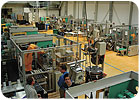Hans Huonker GmbH (Marbach, Germany) employs 85 people and specializes in the manufacture of metal-plastic hybrid parts and assemblies for the automotive industry.

Hans Huonker GmbH has developed a series of modular, robotics-based molding and assembly cells to product hybrid, metal-plastic components for the automotive industry.
To date, the company has installed eight systems in its Marbach plant, one of which assembles ignition switches for the Opel Astra automobile. The production cell consists of an injection-molding machine with a clamping force of 800 kilonewtons, a Stäubli six-axis robot, three bending and trimming presses, a high-voltage test unit and a rotary indexing table.
The company elected to go with Stäubli robots in this and its other cells because of their accuracy. For example, in the ignition switch application, the robot must position an insert with an accuracy of 0.02 millimeter. The robots are also fast and provide the versatility necessary for the company to quickly accommodate product or model changes.
As a first step to assembling the ignition switches, a number of stamped, punched and electroplated blanks are individually loaded into a bending machine, which performs a series of bending operations across 14 different stations. Each fully bent, punched part is then routed to an intermediate processing station where it is rotated 120 degrees and made ready for the robot.
When the system is ready, the robot grips the part and carries it to the cell’s injection-molding machine, where the robot removes any finished components at the same time it inserts the new parts. As the mold is closing, the robot travels to the rotary indexing table, where it places the parts it just took from the injection-molding machine into the table’s fixturing.
In all, there are five stations located on the rotary table. In the first three stations, a series of hydraulic presses separate the leads on the component and turn it around. In the fourth station, the system checks each switch for electrical continuity and the presence of all contact leads. In the fifth station, the system either stamps the part as acceptable or removes it to a reject bin. The robot then removes the completed assembly and places it in a tray.
For additional information on robotic assembly, call 800-257-8235 or visitwww.staubli.com.